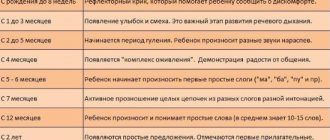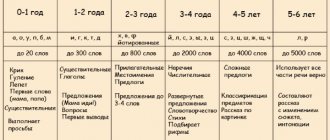Speech apparatus defects
The speech apparatus is a set of organs that are involved in sound pronunciation and speech formation. It consists of 2 sections: central and peripheral. The central part includes the brain, and the peripheral part includes muscles, bones, cartilage, and ligaments. Therefore, when we talk about disorders in the peripheral region, we are talking about the tongue, lips, soft palate and lower jaw. Disruption of the functioning of one or several organs of the speech apparatus at the same time leads to the appearance of speech disorders.
Defects of the speech apparatus, from a diagnostic point of view, can be divided into 2 groups. The first group will include disorders that are diagnosed at an early age; more often, already in the first month of a child’s life, examination reveals disorders that can only be corrected surgically.
The second group includes disorders that cannot be diagnosed at an early age. Their presence becomes known during the development of speech, most often at 2-2.5 years. In this case, you should seek help from a pediatric speech therapist. At the first consultation, the speech therapist will diagnose the disorders and, if necessary, refer you to related specialists.
If the first symptoms of speech disorders occur, you should immediately contact a speech therapist for diagnosis and selection of a correct and effective correction program.
Parents should contact a specialist if they notice:
- Stuttering or pronunciation of words too slow/fast, pauses between words;
- Voice disturbances, nasality, changes in voice timbre;
- Distortion or “swallowing” of sounds, inaudible speech, and others.
Our center’s specialists successfully work with speech apparatus defects; the following methods are most often used to correct speech disorders:
- Speech therapy massage;
- Special speech therapy exercises;
- DENAS therapy;
- Classes using Forbrain (the device can also be purchased for home use);
- Exercises for speech breathing and others.
The most common speech apparatus defects and methods of their correction:
Dysphonia (aphonia) is popularly called “voice disorder” or “vocal disorder”. Signs: lack of phonation or changes in the strength and timbre of the voice, nasality or hoarseness. Requires urgent correction, since with age the symptoms intensify and are less amenable to correction. In the treatment of dysphonia, articulation and breathing exercises, massage of the collar area, and exercises with the DENAS apparatus are most often used.
Stuttering is a disturbance in the tempo, rhythm and fluency of speech caused by convulsions of the speech apparatus. In children, it most often occurs during the development of phrasal speech. In the absence of timely correction, stuttering can accompany a person into adulthood. This disorder is difficult to correct due to its obsessive nature. Treatment of stuttering at the Ember Center is aimed at eliminating the pathological factors that led to the onset of stuttering, as well as neutralizing its consequences, fear of speech - logophobia. It is thanks to an integrated approach that it is possible to get rid of stuttering not temporarily, but forever.
A short frenulum is a defect of the oral cavity, which, as a rule, is congenital. With this disorder, the child cannot pronounce some sounds. Often, with a short frenulum, it is recommended to solve the problem surgically, especially at an early age, when the work of a speech therapist is not yet possible. But this can often be avoided with timely contact with a speech therapist. With the help of special exercises, you can stretch the frenulum, thereby solving this problem.
A dome-shaped palate is a defect of the speech apparatus caused by the incorrect structure of the oral cavity. The speech therapist teaches how to pronounce sounds that are inaccessible to the client, which will not differ from traditional ones by ear.
Rhinolalia (cleft palate) is characterized by a defective structure and functioning of the speech apparatus. A cleft palate interferes with normal voice production. A person with such a defect grossly distorts sounds, pronounces words nasally, and his voice timbre changes. In the treatment of such disorders, a surgical method is often used, after which a course of sessions with a speech therapist is required.
Dysarthria is a violation of the muscle tone of the articulatory apparatus, which contributes to the development of speech production disorders. With dysarthria, speech motor skills, breathing, voice and pronunciation of sounds are impaired. In this case, correctional classes with a speech therapist are aimed at eliminating the cause of the violations. The specialist uses articulation gymnastics, speech therapy massage, and DENAS therapy.
Defects of the speech apparatus are often found in people, but it is in childhood that they can be most effectively treated. With age, correction of these violations becomes more difficult and time-consuming.
Correction of speech apparatus defects at the Ember center is carried out according to an individually developed program. For complex disorders, we recommend a joint consultation with several specialists: a clinical psychologist, a speech pathologist, a special education teacher, and a neuropsychologist. An integrated approach helps to accurately determine the diagnosis and its causes, develop a correction route, without missing important details.
If your child has a speech defect that interferes with normal speech, sign up for a consultation by calling +7 (812) 642-47-02 or leave a request on the website.
Functions and structure of the peripheral part of the speech apparatus.
Peripheral part of the speech apparatus.
Respiratory
The respiratory section of the peripheral speech apparatus forms the energetic basis of speech, providing the so-called speech breathing.
Anatomically, this section is represented by the chest, lungs, bronchi and trachea, intercostal muscles and muscles of the diaphragm. The lungs provide a certain subglottic air pressure. It is necessary for the functioning of the vocal folds, voice modulations and changes in its tonality. During physiological breathing (i.e., outside of speech), inhalation occurs actively due to contraction of the respiratory muscles, and exhalation occurs relatively passively due to the lowering of the chest walls and the elasticity of the lungs.
Voice
The oscillatory movements of the vocal folds generate sound waves.
During phonation, the vocal folds tense, close and produce oscillatory movements. Outside of speech, the folds are moved apart.
The strength of the voice depends mainly on the amplitude (span) of vibrations of the vocal folds, which is determined by the amount of air pressure, i.e., the force of exhalation.
The vocal folds, which are located in the larynx, act as a sound vibrator.
The vocal section consists of the larynx with the vocal folds located in it. The larynx is a wide, short tube consisting of cartilage and soft tissue. It is located in the front of the neck and can be felt through the skin from the front and sides, especially in thin people.
From above the larynx passes into the pharynx. From below it passes into the windpipe (trachea).
At the border of the larynx and pharynx is the epiglottis. It consists of cartilage tissue shaped like a tongue or petal. Its front surface faces the tongue, and its back surface faces the larynx. The epiglottis serves as a valve: descending during the swallowing movement, it closes the entrance to the larynx and protects its cavity from food and saliva.
Modulation of the main and additional tone of the voice
The main resonators of the human voice are the pharynx, oral cavity and nasal cavity with its paranasal sinuses, as well as the frontal cavity.
A certain timbre of voice.
The timbre is given by the cavities of the trachea and bronchi, the chest as a whole, and the laryngeal cavity. Resonators differ among individual people in shape, volume, and the characteristics of their use during speech, which gives the voice an individual timbre coloring. The soft palate and those muscles that cover the space between the nasopharynx and oropharynx take a special part in the resonance effect.
The resonators that are formed by the bones of the skull, namely the nasal cavity, the frontal cavity, do not change their volume, therefore they generate sounds in a very narrow range.
Articulatory
The volume and clarity of speech sounds are created thanks to resonators.
Resonators are located throughout the extension tube - this is everything that is located above the larynx: the pharynx, oral cavity and nasal cavity. When producing speech sounds, the extension pipe performs a dual function: a resonator and a noise vibrator.
Extension pipe.
The muscles of the tongue play a major role in the production of speech sounds. When pronouncing a single speech sound, part of the muscle fiber may be tense, while another part is relaxed. Tension of the articulatory muscle during oral speech is associated not only with the specific work of pronouncing a single sound. It bears the influence of residual stress from the utterance of the previous sound, as well as the preparatory stress associated with the utterance of the subsequent sound, which are part of the word (coarticulation). In addition, the emotional state in which the speaker is
also affects the degree of muscle tension of both the tongue and the entire speech apparatus. Thus, the muscles of the tongue experience a complex of different influences.
The tongue is a massive muscular organ. When the jaws are closed, it fills almost the entire oral cavity. The front part of the tongue is mobile, the back part is fixed and is called the root of the tongue. The movable part of the tongue is divided into the tip, the leading edge (blade), the lateral edges and the back. The complexly intertwined system of tongue muscles and the variety of their attachment points provide the ability to change the shape, position and degree of tension of the tongue within a wide range. This is very important, since the tongue is involved in the formation of all vowels and almost all consonant sounds (except labials).
Plays an important role in the formation of speech sounds. Articulation consists in the fact that the listed organs form slits, or closures, that occur when the tongue approaches or touches the palate, alveoli, teeth, as well as when the lips are compressed or pressed against the teeth.
Lower jaw, lips, teeth, hard palate, alveoli.
During quiet breathing, the soft palate is relaxed, partially closing the entrance to the oral cavity from the pharynx. During deep breathing, yawning and speech, the velum palatine rises, opening the passage into the oral cavity and, conversely, closing the passage into the nasopharynx.
Soft sky.
They take part in pronouncing all the sounds of the Russian language.
Oral cavity and pharynx.
Literature:
1. Volosovets T.V.; Overcoming general speech underdevelopment in preschool children. Educational and methodological manual / Ed. ed. - M.: V. Sekachev, 2007. - 224 p.
2. Gvozdev A. N. From first words to first grade. Diary of scientific observations. Saratov: Saratov University Publishing House, 1981
3. Speech therapy: Textbook. for students defectol. fak. ped. higher textbook institutions / Ed. Volkova L.S., Shakhovskaya S.N.;
4. Luria A. R.; Fundamentals of neuropsychology. Textbook aid for students higher textbook establishments. - M.: Publishing House, 2003. - 384 p.
5. Chirkina G.V. Programs of compensatory preschool educational institutions for children with speech impairments. – M.: Education, 2009.
Structure of the vocal apparatus
The human vocal apparatus consists of the following three sections: the respiratory organs, which provide the stream of exhaled air necessary for voice formation; the larynx with the vocal cords as the direct voice-forming apparatus; extension pipe, that is, the cavities of the mouth and nasopharynx, which play the role of resonators that enhance the sound generated in the larynx and give it an individual timbre coloring. A resonator is a hollow body filled with air and having a hole. It enhances the sound and gives it a timbre coloring. The main resonators in the process of speech production are the chest, mouth and nasal, and the chest resonator is often called the “foundation of the voice.” Excessive participation of the nasal resonator in the process of speech formation, most often associated with the presence of palatal clefts or paresis of the soft palate, leads to the appearance of a nasal tone of the voice - rhinophonia (only the voice suffers) or rhinolalia (along with the voice, sound pronunciation is also impaired). Normally, the vocal cords can be in two main positions - closed and open. The ligaments are open during breathing outside of speech, which allows the air stream to pass freely through the larynx both during inhalation and exhalation. They are also in an open position during whispered speech, as well as during the articulation of voiceless consonant sounds (P, T, K, S, Sh, F, X, Ts, Ch, Shch). If we put our hand on the larynx (front of the neck) at this time, we will not feel any vibration in this area. During the process of voice formation (when pronouncing vowels and all voiced consonant sounds), the ligaments tightly close together and come into a state of vibration, which can be felt with a hand applied to the larynx. It is through this vibration of the vocal cords that the voice is formed. What reasons can lead to voice disorders? There are many such reasons, they are extremely diverse and, moreover, they play a far from clear role in the origin of voice disorders.
Let's name the most common ones:
diseases and traumatic injuries of the larynx and vocal cords;
violations of the resonator system; diseases of the respiratory system (lungs, bronchi, trachea); diseases of the heart and cardiovascular system; endocrine disorders (in particular, thyroid diseases); hearing impairments that complicate the overall “tuning” of the voice-producing apparatus due to the absence or insufficiency of auditory control; long-term smoking; systematic use of alcohol; exposure to pesticides; frequent stay in dusty rooms; systematic overstrain of the voice, especially when used incorrectly; sudden temperature fluctuations (in particular, drinking cold water and especially cold milk and juices when hot); mental trauma. All causes of voice disorders are conventionally divided into organic and functional. Organic ones include those that cause changes in the anatomical structure of the vocal apparatus in its peripheral or central parts. The action of functional causes does not cause visible changes in the structure of the vocal apparatus, but only disrupts its normal functioning. In accordance with the classification of causes, voice disorders themselves are divided into organic and functional. Trainer T4K buy in Moscow - go to catalog Mouth expander in Moscow - go to catalog










